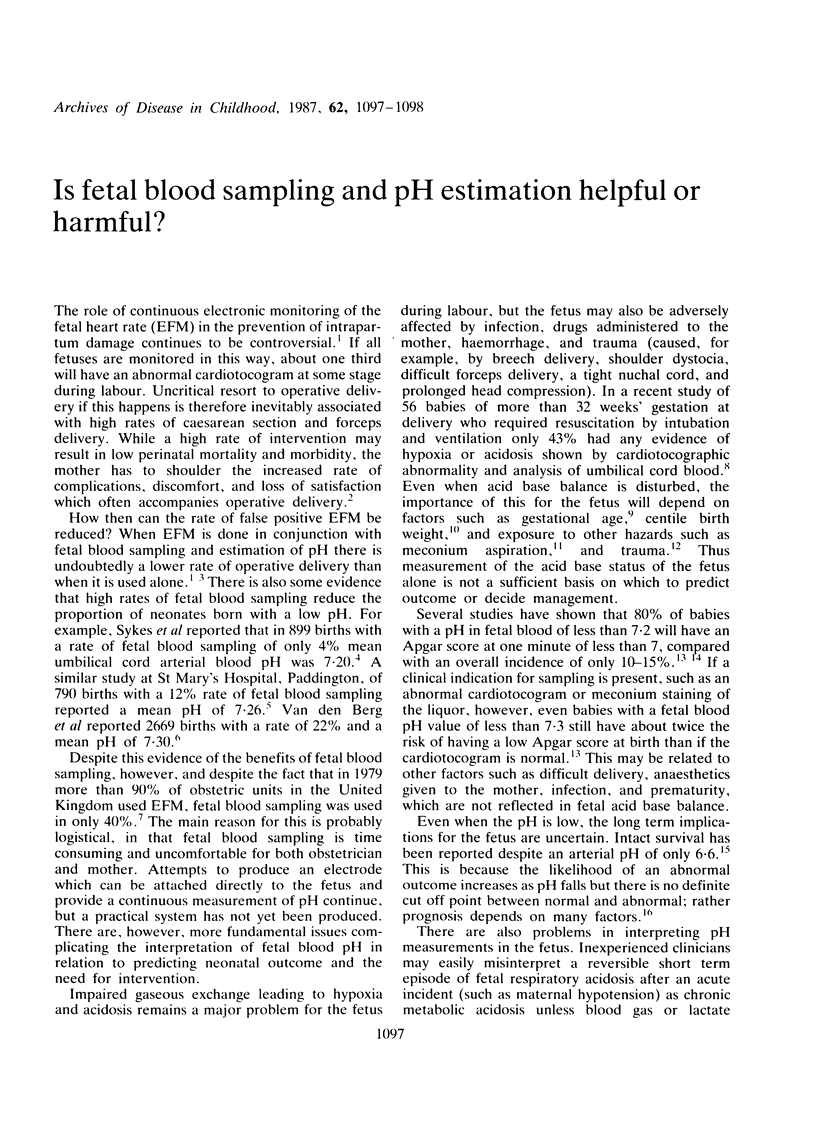Full text
PDF

Selected References
These references are in PubMed. This may not be the complete list of references from this article.
- Altman D. G. Statistics: necessary and important. Br J Obstet Gynaecol. 1986 Jan;93(1):1–3. doi: 10.1111/j.1471-0528.1986.tb07802.x. [DOI] [PubMed] [Google Scholar]
- Fleischer A., Schulman H., Jagani N., Mitchell J., Randolph G. The development of fetal acidosis in the presence of an abnormal fetal heart rate tracing. I. The average for gestational age fetus. Am J Obstet Gynecol. 1982 Sep 1;144(1):55–60. doi: 10.1016/0002-9378(82)90394-5. [DOI] [PubMed] [Google Scholar]
- Fysh W. J., Turner G. M., Dunn P. M. Neurological normality after extreme birth asphyxia. Case report. Br J Obstet Gynaecol. 1982 Jan;89(1):24–26. doi: 10.1111/j.1471-0528.1982.tb04629.x. [DOI] [PubMed] [Google Scholar]
- Gillmer M. D., Combe D. Intrapartum fetal monitoring practice in the United Kingdom. Br J Obstet Gynaecol. 1979 Oct;86(10):753–758. doi: 10.1111/j.1471-0528.1979.tb10689.x. [DOI] [PubMed] [Google Scholar]
- Haverkamp A. D., Orleans M., Langendoerfer S., McFee J., Murphy J., Thompson H. E. A controlled trial of the differential effects of intrapartum fetal monitoring. Am J Obstet Gynecol. 1979 Jun 15;134(4):399–412. doi: 10.1016/s0002-9378(16)33082-4. [DOI] [PubMed] [Google Scholar]
- Hobel C. J., Hyvarinen M. A., Oh W. Abnormal fetal heart rate patterns and fetal acid-base balance in low birth weight infants in relation to respiratory distress syndrome. Obstet Gynecol. 1972 Jan;39(1):83–88. [PubMed] [Google Scholar]
- Leveno K. J., Cunningham F. G., Pritchard J. A. Cesarean section: an answer to the House of Horne. Am J Obstet Gynecol. 1985 Dec 15;153(8):838–844. doi: 10.1016/0002-9378(85)90686-6. [DOI] [PubMed] [Google Scholar]
- Low J. A., Galbraith R. S., Muir D. W., Killen H. L., Pater E. A., Karchmar E. J. Factors associated with motor and cognitive deficits in children after intrapartum fetal hypoxia. Am J Obstet Gynecol. 1984 Mar 1;148(5):533–539. doi: 10.1016/0002-9378(84)90742-7. [DOI] [PubMed] [Google Scholar]
- MacDonald D., Grant A., Sheridan-Pereira M., Boylan P., Chalmers I. The Dublin randomized controlled trial of intrapartum fetal heart rate monitoring. Am J Obstet Gynecol. 1985 Jul 1;152(5):524–539. doi: 10.1016/0002-9378(85)90619-2. [DOI] [PubMed] [Google Scholar]
- Sykes G. S., Molloy P. M., Johnson P., Stirrat G. M., Turnbull A. C. Fetal distress and the condition of newborn infants. Br Med J (Clin Res Ed) 1983 Oct 1;287(6397):943–945. doi: 10.1136/bmj.287.6397.943. [DOI] [PMC free article] [PubMed] [Google Scholar]
- Tejani N., Mann L. I., Bhakthavathsalan A. Correlation of fetal heart rate patterns and fetal pH with neonatal outcome. Obstet Gynecol. 1976 Oct;48(4):460–463. [PubMed] [Google Scholar]
- van den Berg P., Schmidt S., Gesche J., Saling E. Fetal distress and the condition of the newborn using cardiotocography and fetal blood analysis during labour. Br J Obstet Gynaecol. 1987 Jan;94(1):72–75. doi: 10.1111/j.1471-0528.1987.tb02256.x. [DOI] [PubMed] [Google Scholar]


